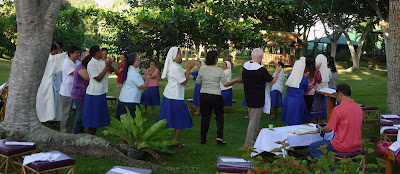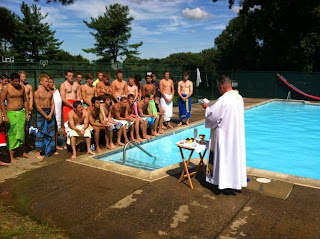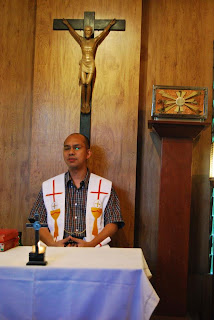So might as well, give him/her a shout out...
Let the statements of the new archbishop of Chicago, Archbishop Blaise Cupich be the judge of his character shall we?
***
Perhaps the most noticeable result of this new emphasis on the communal nature of the Church and its witness of solidarity came with the development of new designs by Church architects.
[Oh yes! Like this "development".]
Their plans for renovations and new churches gave greater attention to the needs of the assembly as it gathered and worshiped as the Body of Christ. [What needs? I guess the Council Fathers talked about that didn't they? The need to make things inside the church less "churchy" and more drabby.]
In particular, the design and location of the altar was changed to reflect this. Once distanced from the people and in an area off-limits to them, the altar was now to be designed and situated so that people could understand that at Mass, Christ takes the initiative. He, in the symbol of the altar, gathers the people around as members of His Body to join in His offering of praise to the Father. [Because the High Altar of st. Peter's Basilica, is too far from the people, so we used Italian instead of Latin so people can "understand" the Mass. But wait. The Mass now IS in the vernacular and the High Altar of St. Peter's remain where it has been for centuries. And....and....the portable altar used in papal Masses in St. Peter's square is....uhm....near?.....the people? So, the bishop was saying that to make things more understandable to the people we need to bring the altar closer to the people? If the altar is too far, people would not recognize that Christ is taking the initiative? Like this one below.]
To move ahead in this area, and make the proclamation of the Gospel more effective, the active promotion of Christian unity had to become part of the Church’s self-understanding of what it means to be faithful to Christ. [Uh-huh.]
As a result, Catholics were encouraged to gather with our “separated brothers and sisters” in prayer and non-Eucharistic forms of worship. [Last I read, SOMEONE just wants to pick a fight with them and CALL THEM names. Not pray pray with them.] In this new ecumenical environment, various liturgical reforms considered at the Council of Trent but rejected lest they be interpreted as a compromise to those attacking the Church (e.g., Communion from the cup and Mass in the vernacular), could now be reassessed on their own merits. [Yeah like this kind.]

[Because receiving Communion this way is baaadd for your soul....and not ecumenical...]

The Church also faced the challenges of adapting to the changes in the world order in those times. The world was no longer going to be dominated by the West. Colonialism had given way to the emergence of new nations in Asia, Africa and South America. [The Church spread to the corners of the globe without thinking about the West - East divide.]
The Council responded by calling the Church to a new openness toward these non-western cultures, particularly when it came to worship. [Did the Church say that in the Constitution on the Liturgy Sacrosanctum Concilium? Nope.] The Church now considered it important to pursue inculturation. [Try finding the word 'inculturation' in SC. Hit control "f", you won't find it because the Council Fathers did not even think about this. And as far as I could remember, the inculturated Mass, Misa ng Bayang Pilipino is STILL ILLEGAL.] This meant reexamining and being open to how the spirituality of these cultures and traditions could legitimately contribute to the worship of Catholics in these emerging nations and to the universal Church. The former rule of strict and rigid uniformity in the liturgy now gave way to an openness to legitimate diversity. [No wonder we have this kind of "Mass".]

Finally, perhaps the most serious challenge facing the Church was internal, the need to invigorate the Christian life of each individual believer. Many bishops were becoming increasingly concerned that a good number of Catholics were questioning the significance of the Christian faith and religious practice.
Over the centuries, a split developed in this regard. Literally and figuratively, the laity became distanced from the public worship of the Church. The priest did virtually everything.
The rites were in a language unknown to most. The accumulation of ritual actions, many of which had their origins in the royal courts of Europe, made the meaning of rites even less accessible to the common person. The people were reduced to passive attendance as silent spectators. [yeah, right. the people were just looking. They were not praying. Because active participation
As a result, the sacramental life of the Church was no longer, at least in practice, the primary source of nourishment for the spiritual life of people. [Before Vatican II, people were not pious and religious anymore. That's what he and liberal bishops love to think and preach.] Instead of relying on the transforming power of the Eucharist as the source of their spiritual lives, people did their best to find nourishment in individualistic piety and personal devotions. [People were so into the dark dark dark corners of their lives, people. Pitiful.]
In view of this, it is not surprising that the bishops called for a renewal of the liturgical life of the Church that would lead to the full, active and conscious participation of the faithful. [And so we have these!]





[full, active and conscious participation of the faithful! Enriching the life of the Church! Yeah!]
This would require both reform and restoration. The reform began with the call for a return to the noble simplicity of the Roman rite. Those features that had crept in over time had to be removed so that the rites would be short, clear, not weighed down by useless repetitions. [And so we have a Eucharistic Prayer invented in a Roman Tavern! SOMEONE will be frothing in the mouth again. Yeah, like Fr. Louis Bouyer was not a member of the Consilium that MADE the NEW Eucharistic Prayer, like there is NO evidence WHATSOEVER that it is from St. Hippolytus!]
The aim was to make sure that ordinary people could understand what is going on without much explanation. [Yeah, like I saw two reporters of TV5, one a graduate of Catholic university De La Salle in Taft, the other in Katipunan avenue which is barely Catholic Ateneo, ask the priest what part he is seeing in the Mass of the Canonization of John Paul II and John XXIII. It is STILL the Mass. And they cannot even tell that it was the Offertory procession. Yeah. The people understand what is going on in the Mass because it is in the vernacular and the people are gathered around the altar.] But, it was also important to return to those forms of worship which the Church had in its rich treasury of liturgical tradition of the Roman rite. [Like these?]



This restoration came in a variety of ways: the revival of Holy Week services, [because, according to his wild imagination, there were no Holy Week services before Vatican II so all the people were in the provinces, partying in the beaches and.....oh! That is today isn't it?] the Rites of Christian Initiation and the Easter Vigil, the reestablishment of the Liturgy of the Word with a greater selection of Scripture readings, the return of ministries by the laity at Mass. [The laity had an ANCIENT role in the Mass???? Did I miss something in Theology school or WHAT?!]
These forms and aspects of the Roman rite served the Church well over the ages as a perennial source of nourishment for the spiritual lives of believers and needed to be restored. As a result, when the renewal as reform and restoration took place, the Church was able to honestly say that the reformed Mass was both a witness to an unbroken tradition of the Roman rite and an improvement on the former one (General Instruction of the Roman Missal, 2000, #6). [Like Eucharistic Prayer II is an "unbroken tradition". Yeah....right.]
***
If this is not a case of historical revisionism, then Hitler must deserve a Nobel Peace prize.
Our poor ancestors. They weren't nourished by the Sacraments then because they just sit on the pews, staring blankly into the sanctuary....
Where did we learn our Faith then?
Sesame Street?
Hey! Is it the season to promote bishops from small dioceses who did nothing there and they get transferred to big and prestigious archdioceses with a chance to become a cardinal????
Is it?

An italian blog is reporting that the MBP is illegal.
ReplyDelete